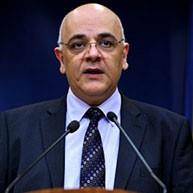Smart and Risk-Informed Decision-Making: Prioritizing and Costing Investments in Disaster and Climate Resilience
Proactive disaster prevention and preparedness, climate adaptation, risk-based decision-making, limited financial resources, strategic collaboration, practical tools and methodologies, critical infrastructure resilience, community involvement, financial management, continuous improvement and adaptation. The session focused on making smart and informed investments in disaster and climate resilience, emphasizing scaling up prevention and preparedness. Reports from the World Bank and the European Commission under the Economics for Disaster Prevention and Preparedness (EDDP) framed the discussion, providing data, tools, and evidence for policymakers to enhance resilience strategies. The session brought together perspectives from the European Commission, line ministries, and city levels, highlighting both challenges and opportunities. Lessons from Romania highlighted experience in leveraging risk data and strategic prioritization to optimize investments in critical infrastructure, ensuring targeted and impactful resilience investments Challenges included limited financial resources and the need for coordinated planning. To address these, the Ministry prioritized critical infrastructure, such as fire stations, enabling phased funding and mobilization of resources from national and international sources. The Ministry’s strategic planning and partnerships, including collaborations with civil society, have integrated innovative and inclusive approaches. Romania emphasized the benefits of knowledge exchange in building disaster risk management (DRM) capacity within the government, the EU, and globally. Lessons from Sendai City highlighted initiatives to enhance disaster and climate resilience in Sendai City. Committed to becoming a “Disaster-Resilient and Environmentally-Friendly City,” Sendai has been enhancing infrastructure resilience, energy efficiency, and community-based DRM activities. Despite challenges, such as adapting to diversifying disaster risks and fostering public awareness, Sendai advances its resilience agenda through continuous collaboration and community involvement, through Initiatives like developing Regional Disaster Prevention Leaders to empower local leaders, ensuring a culture of preparedness. Integrating disaster risk reduction into all aspects of urban planning and policymaking is key. By embedding resilience measures into infrastructure projects, decision-makers can create a comprehensive, proactive approach to disaster preparedness, ensuring long-term safety and resilience. Lessons from the EU’s efforts to scale up investments in disaster and climate resilience highlighted capacities available under the Union Civil Protection Mechanism (UCPM), such as the Knowledge Network. A significant policy achievement is the adoption of the Disaster Resilience Goals (DRGs), with the need for investments at all levels to achieve the DRGs was emphasized, particularly in critical sectors providing emergency response services. Insights from EDPP were shared, showing that investments in DRM make economic sense. Key challenges include regulatory hurdles and the need for coordinated efforts across countries and agencies. Tools available to bolster the EU’s DRM capacity include Peer Reviews and DRM specific funding/technical assistance. The session underscored the importance of knowledge sharing and fostering collaboration on DRM to ensure an effective framework and enhance overall resilience. Integrated approaches and sharing best practices are crucial to addressing the challenges posed by disasters and climate change effectively. Key highlights from the EDDP analytics were presented, emphasizing the importance of timely action and managing disaster and climate risks. Key takeaways included the need for data-driven decision-making and smart, focused investments in disaster and climate resilience, the importance of starting now with costing climate change adaptation measures, and better understanding financial impacts for more efficient public finance management.
“Do not let the imperfection be the enemy of the good. There is no database that is too patchy, there is no budget that is too small to start taking action on mapping the most impactful investment needs and to start bringing these issues to the political level.”
The session was a call to action for smarter, more focused investments in DRM to safeguard communities and ensure future climate and disaster resilience. Insights shared by experts from Romania, Japan, the European Commission, and the World Bank offered valuable lessons and strategies relevant to other countries. Prioritizing ex-ante investments can be challenging amidst limited financial resources and competing needs. Inherent uncertainties, such as the unpredictability of major disaster events, make it challenging for policymakers at different administrative levels to prepare and implement climate and DRM investments. Despite progress, more work is needed to effectively operationalize lessons learned and adapt to evolving challenges, such as through the Technical Assistance Financing Facility (TAFF) or the EDDP eLearning modules. There is a high demand for quality information and best practices in disaster risk management – equipping stakeholders with necessary tools and information empowers informed decision-making and improves their ability to tackle future challenges. Key takeaways from the session: 1. Shift to Smart, Prioritized Investments Linking DRM and Climate Change Adaptation (CCA): There is a crucial need to shift from reactive disaster response to proactive disaster prevention and preparedness while taking action on climate adaptation. Focused investments are necessary to strengthen critical sectors to disaster and climate risks, transforming potential crises into opportunities for growth and resilience. 2. The Best Time to Act is Now: Several opportunities exist to invest proactively and smartly to address today’s disaster and climate risks. Countries must begin developing ‘adaptation pathways’—decision-making approaches that allow them to prepare and take actions amid uncertainty—using current and future climate risk information. Early action can transform vulnerability into resilience. 3. Evidence and Data Drive Decision-Making: Utilizing disaster risk data and evidence to guide decision-making is crucial for smart investments. Risk assessment and cost estimation can help understand the benefits and costs of investments, guiding prioritization and policy decisions in prevention and preparedness. 4. Use Prioritization Tools and prioritize critical infrastructure: A range of tools, such as multi-criteria analysis and triple dividend of resilience, can guide decision-makers in prioritizing and guiding investments. Protecting critical infrastructure is the cornerstone for disaster and climate resilience. Identifying hotspots where infrastructure is exposed to multiple hazards/future climate projections can help policymakers prioritize investments that yield significant impact. 5. Focus on DRM Now Because of Climate Change: Costing approaches for smart investments in disaster and climate resilience underscore the importance of making risk-informed, data-driven decisions. There is an opportunity to shift from incremental measures towards system-level transformational adaptation. 6. Efficient Financial Management: Improving financial resilience by better using available data and instruments can alleviate the pressure on constrained budgets. Enhancing financial resilience through risk financing mechanisms is crucial for managing disaster risks. These efforts ensure resources are available when needed. 7. The Power of Community: Collaboration and stakeholder involvement to share knowledge, fosters a culture of preparedness are key for building resilience and ensuring effective DRM and climate adaptation. Building comprehensive resilience requires coordinated efforts, as no single entity can address the multifaceted challenges posed by disasters and climate change alone.
Organized by: World Bank, European Commission





